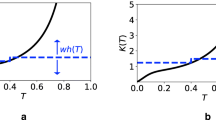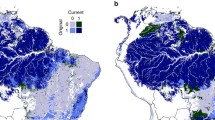Abstract
The role of fire in expanding the global distribution of savanna is well recognized. Empirical observations and modeling suggest that fire spread has a threshold response to fuel-layer continuity, which sets up a positive feedback that maintains savanna–forest bistability. However, modeling has so far failed to examine fire spread as a spatial process that interacts with vegetation. Here, we use simple, well-supported assumptions about fire spread as an infection process and its effects on trees to ask whether spatial dynamics qualitatively change the potential for savanna–forest bistability. We show that the spatial effects of fire spread are the fundamental reason that bistability is possible: because fire spread is an infection process, it exhibits a threshold response to fuel continuity followed by a rapid increase in fire size. Other ecological processes affecting fire spread may also contribute including temporal variability in demography or fire spread. Finally, including the potential for spatial aggregation increases the potential both for savanna–forest bistability and for savanna and forest to coexist in a landscape mosaic.





Similar content being viewed by others
Notes
Note that this constitutes a slight departure from Staver et al. (2011a), but one that more accurately reflects the reality of fire spread.
The grass cluster of \(z\) is defined as the set of Grass cells \(z'\), each of which is connected to \(z\) by some continuous Grass path, i.e. by a sequence \(\pi = (z_1, \ldots , z_n)\) with \(z_1 = z\) and \(z' = z_n\), such that for each \(i < n\), the sites \(z_i\) and \(z_{i+1}\) are two neighboring Grass patches. Finally, the density of a cluster \(F(z)\) is defined as the number of sites in the cluster renormalized by the number of sites in the landscape.
More precisley, \(T_\sigma (z) := \frac{1}{Z}\sum _{z' \ \text {is a Tree}} \exp (-\frac{(z-z')^2}{2 \sigma ^2})\) where \(Z\) is the renormalization constant such that \(\sum _{z'} \exp (-\frac{(z-z')^2}{2 \sigma ^2})=Z\).
References
Archibald S, Bond W, Stock W, Fairbanks D (2005) Shaping the landscape: fire-grazer interactions in an African savanna. Ecol Appl 15(1):96–109
Archibald S, Roy DP, Van Wilgen BW, Scholes RJ (2009) What limits fire? An examination of drivers of burnt area in Southern Africa. Global Change Biol 15(3):613–630
Archibald S, Staver AC, Levin SA (2012) Evolution of human-driven fire regimes in Africa. PNAS 109(3):847–852
Beckage B, Ellingwood C (2008) Fire feedbacks with vegetation and alternative stable states. Complex Syst 18:159–171
Beckage B, Platt WJ, Gross LJ (2009) Vegetation, fire, and feedbacks: a disturbance-mediated model of Savannas. Am Nat 174(6):805–818
Binney JJ, Dowrick NJ, Fisher AJ, Newman M (1992) The theory of critical phenomena: an introduction to the renormalization group. Oxford University Press, Oxford
Bond WJ (2008) What limits trees in C-4 grasslands and savannas? Annu Rev Ecol Evol Syst 39:641–659
Bond W, Midgley J (2001) Ecology of sprouting in woody plants: the persistence niche. Trends Ecol Evol 16(1):45–51
Durrett R, Levin S (1994) The importance of being discrete (and Spatial). Theor Popul Biol 46(3):363–394
Good SP, Caylor KK (2011) Climatological determinants of woody cover in Africa. Proc Natl Acad Sci 108(12):4902–4907
Govender N, Trollope WSW, Van Wilgen BW (2006) The effect of fire season, fire frequency, rainfall and management on fire intensity in savanna vegetation in South Africa. J Appl Ecol 43(4):748–758
Grimmett G (1999) Percolation, 2n edn. Grundlehren der mathematischen Wissenschaften, vol 321. Springer, Berlin
Hennenberg K, Fischer F, Kouadio K, Goetze D, Orthmann B, Linsenmair K et al (2006) Phytomass and fire occurrence along forest-savanna transects in the Como National Park, Ivory Coast. J Trop Ecol 22(03):303–311
Higgins S, Bond W, Trollope W (2000) Fire, resprouting and variability: a recipe for grass-tree coexistence in savanna. J Ecol 88(2):213–229
Hirota M, Holmgren M, Van Nes EH, Scheffer M (2011) Global resilience of tropical forest and savanna to critical transitions. Science 334(6053):232–235
Hochberg ME, Menaut JC, Gignoux J (1994) The influences of tree biology and fire in the spatial structure of the West African savannah. J Ecol 217–226
Hoffmann W, Solbrig O (2003) The role of topkill in the differential response of savanna woody species to fire. Forest Ecol Manag 180(1–3):273–286
Hoffmann W, Adasme R, Haridasan M, T de Carvalho M, Geiger E, Pereira M, et al (2009) Tree topkill, not mortality, governs the dynamics of savanna–forest boundaries under frequent fire in central Brazil. Ecology 90(5):1326–1337
Holdo RM, Sinclair ARE, Dobson AP, Metzger KL, Bolker BM, Ritchie ME, Holt RD (2009) A disease-mediated trophic cascade in the serengeti and its implications for ecosystem C. Plos Biol 7(9):e1000210
Lehmann CE, Archibald SA, Hoffmann WA, Bond WJ (2011) Deciphering the distribution of the savanna biome. New Phytol 1–19
Levin SA, Durrett R (1996) From individuals to epidemics. Philos Trans R Soc B Biol Sci 351(1347):1615–1621
Lewis SL, Brando PM, Phillips OL, van der Heijden GMF, Nepstad D (2011) The 2010 amazon drought. Science 331(6017):554–554
Nathan R, Muller-Landau HC (2000) Spatial patterns of seed dispersal, their determinants and consequences for recruitment. Trends Ecol Evol 15(7):278–285
Prior LD, Williams RJ, Bowman DM (2010) Experimental evidence that fire causes a tree recruitment bottleneck in an Australian tropical savanna. J Trop Ecol 26:595–603
Pueyo S, de Alencastro Graa PML (2010) Testing for criticality in ecosystem dynamics: the case of Amazonian rainforest and savanna fire. Ecol Lett 13(7):793–802
Sankaran M, Ratnam J, Hanan NP (2004) Tree-grass coexistence in savannas revisited-insights from an examination of assumptions and mechanisms invoked in existing models. Ecol Lett 7(6):480–490
Schutz AEN, Bond WJ, Cramer MD (2009) Juggling carbon: allocation patterns of a dominant tree in a fire-prone savanna. Oecologia 160(2):235–246
Staver AC, Levin SA (2012) Integrating theoretical climate and fire effects on savanna and forest systems. Am Nat 180(2):211–224
Staver AC, Archibald S, Levin SA (2011a) The global extent and determinants of savanna and forest as alternative biome states. Science 334(6053):230–232
Staver AC, Archibald S, Levin SA (2011b) Tree cover in sub-Saharan Africa: rainfall and fire constrain forest and savanna as alternative stable states. Ecology 92(5):1063–1072
Sullivan AL (2009) Wildland surface fire spread modelling, 1990–2007. 3: simulation and mathematical analogue models. Int J Wildland Fire 18(4):387–403
van Wilgen B, Govender N, Biggs H, Ntsala D, Funda X (2004) Response of savanna fire regimes to changing fire? Management policies in a large African national park. Conserv Biol 18(6):1533–1540
Zinck RD, Grimm V (2009) Unifying wildfire models from ecology and statistical physics. Am Nat 174(5):E170–E185
Acknowledgments
We acknowledge S. Archibald for helpful discussions. Funding for this work was provided by “The Emergence And Evolution of Ecosystem Functioning” from the Andrew W. Mellon Foundation.
Author information
Authors and Affiliations
Corresponding author
Electronic supplementary material
Below is the link to the electronic supplementary material.
Rights and permissions
About this article
Cite this article
Schertzer, E., Staver, A.C. & Levin, S.A. Implications of the spatial dynamics of fire spread for the bistability of savanna and forest. J. Math. Biol. 70, 329–341 (2015). https://doi.org/10.1007/s00285-014-0757-z
Received:
Published:
Issue Date:
DOI: https://doi.org/10.1007/s00285-014-0757-z




